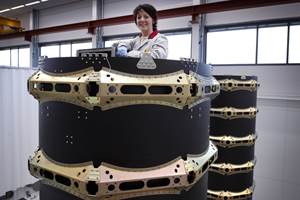Composites education: Improvement through collaboration
The American Composites Manufacturers Assn.'s (Arlington, Va.) chief staff executive Tom Dobbins contends that composites education will advance more quickly if the industry moves toward consistent, standardized curricula for basic and advanced training.
In recent issues of Composites Technology, industry consultant Andre Cocquyt (GRPguru.com, Brunswick, Maine) talked about the importance of education and training to the future of the composites industry (see the titles under "Editor's Picks," at right). He is correct. In fact, it’s unlikely that composites materials will achieve widespread adoption without a viable education and training infrastructure. The questions are: What will the infrastructure look like? and How will we ensure that it provides useful education?
Cocquyt noted the proliferation of new training programs dedicated to the composites industry. These programs reflect the need for a trained workforce, but they’re often created in a vacuum, serving the requirements of one company, region or market. Other programs reinvent the wheel.
The American Composites Manufacturers Assn. (ACMA) believes that composites education will advance more quickly if the industry moves toward consistent, standardized curricula for basic and advanced training, developed through best practices and industry collaboration. That was and still is the goal of ACMA’s Composites Certification Training (CCT) program and its other education programs.
The purpose of the CCT standardized curricula is to establish the baseline skills required for composites industry employees to perform their jobs. It should support best practices endorsed by the industry at large. In the case of composites technicians specifically, it should promote skills that lead to the manufacture of high-quality products.
Companies of all sizes rely on the CCT program, but smaller companies are especially dependent on the program to provide new employees with an introduction to composites and basic training. Without an independent curricula based on best practices, employee training would depend on the quality of whatever education happened to be available, which could have a narrow focus.
The composites industry can’t afford to leave employee training to chance. Whenever a company employs unskilled workers who produce low-quality products, it affects the entire industry’s ability to compete with established materials. It only takes a few horror stories before end-users question the entire industry.
The increasing amount of composites imports from other countries, without skilled and educated labor in the U.S., further underscores the need for the U.S. composites industry to continue to raise the bar on its employee training. Global competition is here, and quality is one area in which the industry must maintain its leadership status. Programs like CCT — developed by a collective industry voice — provide a mechanism to do this.
When the industry invests in standardized education and training, it develops a skilled workforce that consistently produces high-quality products. Not only does this help address competition from overseas or south of the border, but it also reassures end-users that composites are the material of choice over more traditional materials.
What should be taught?
The availability of federal and state grant money is one reason for the sudden increase in new composites education programs, as Cocquyt pointed out. Another reason is that the composites industry is diverse, and companies often seek custom-tailored training for employees. Yet all composites industry workers benefit from having certain fundamental knowledge, including the history of composites, basic terminology, standard manufacturing processes, material properties and plant safety.
For universal curricula to exist, representatives from across the industry have to jointly decide what specific information to include in each of these areas. As far as we know, the CCT program is the only composites education model that relies on input from the industry at large. ACMA members collaborate to identify best practices, which ensure that the education is useful across companies, regions and markets.
ACMA agrees with Cocquyt’s assertion that curricula for basic composites training have been adequately addressed. The process of updating CCT curricula always will be ongoing, but the model for updating basic education and gaining industrywide support is established and effective.
Furthermore, CCT has laid the foundation for developing subsequent training curricula to gain industry-wide support. ACMA members regularly review not only the content of the programs but also the ways in which they’re administered. The result is an ongoing industry effort to improve the CCT program at every level. For example, ACMA recently published a new CCT program — the Vacuum Infusion Program — and is working on Light RTM and Repair and Inspection programs as well. Recently, ACMA also updated the first CCT program on Open Molding.
Beyond education about new processes and technology, ACMA recognizes that hands-on training is a critical component of a composites technician’s education. Additionally, there is a need for more advanced training than what is currently found in CCT. The industry has come a long way since CCT was introduced more than 10 years ago. ACMA’s strategic plan calls for a look at how both of these needs should be addressed. In the meantime, ACMA offers specialized and more advanced education through other means, including demonstrations at its COMPOSITES trade show and regional workshops, articles in Composites Manufacturing magazine as well as niche-market events and online training through webinars.
Because the CCT program is modular, ACMA can decide at any time to add new and advanced curricula, as is being done through continual program updates and new program additions. The modular program also means that others — such as technical schools and academia — can use the program and add to it to meet the needs of the companies in their geographic area. In fact, ACMA already has partnered with 10 schools, allowing them to use the CCT program as the basis for their composites education. This provides consistency across a broad geographic area and enables ACMA to gather valuable feedback on the need for developing additional training.
In all of these cases, the process by which educational topics are prioritized is collaborative. This ensures that the programs fit industrywide needs and impart best practices. Both projects began because there was consensus among members that a need existed for standardized education in these areas.
Time will tell what other programs ACMA generates or how ACMA addresses the need for more advanced composites education, but one thing is certain: The collaborative process facilitated through ACMA results in training programs that reflect industry needs and will be accepted by the industry. This is the only way to produce standardized training that will be universally recognized, and it will raise the consistency of the products produced by our industry, allowing U.S. companies to successfully compete on a global level.
Related Content
RUAG rebrands as Beyond Gravity, boosts CFRP satellite dispenser capacity
NEW smart factory in Linköping will double production and use sensors, data analytics for real-time quality control — CW talks with Holger Wentscher, Beyond Gravity’s head of launcher programs.
Read MoreMFFD thermoplastic floor beams — OOA consolidation for next-gen TPC aerostructures
GKN Fokker and Mikrosam develop AFP for the Multifunctional Fuselage Demonstrator’s floor beams and OOA consolidation of 6-meter spars for TPC rudders, elevators and tails.
Read MoreMaterials & Processes: Fabrication methods
There are numerous methods for fabricating composite components. Selection of a method for a particular part, therefore, will depend on the materials, the part design and end-use or application. Here's a guide to selection.
Read MoreMaterials & Processes: Fibers for composites
The structural properties of composite materials are derived primarily from the fiber reinforcement. Fiber types, their manufacture, their uses and the end-market applications in which they find most use are described.
Read MoreRead Next
The state of education in the composites trade, part I
Andre Cocquyt (GRPguru, Brunswick, Maine) renews his call to focus composites industry efforts on finishing and financing a comprehensive unitary composites education model at the national level.
Read MoreThe state of education in the composites trade, part II
Andre Cocquyt (GRPguru.comm, Brunswick, Maine) continues his call for a unified national composites education standard, and suggests a practical way forward toward that goal.
Read MoreFrom the CW Archives: The tale of the thermoplastic cryotank
In 2006, guest columnist Bob Hartunian related the story of his efforts two decades prior, while at McDonnell Douglas, to develop a thermoplastic composite crytank for hydrogen storage. He learned a lot of lessons.
Read More


























